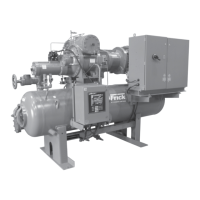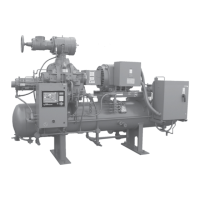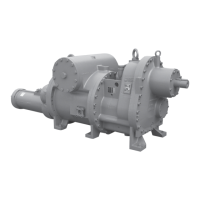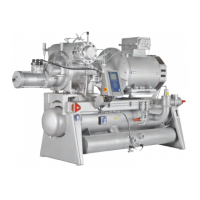210.100-IOM (JUL 2021)
Page 7
AcuAir Hygienic Air Units
Pre-installation requirements
Training and safety considerations
The AcuAir
®
precision-engineered hygienic air systems
provided by Johnson Controls-Frick, use the nest in
HVACR materials and corrosion protection to deliver
dependable, consistent, and accurate control of tempera-
ture and humidity in process rooms. This manual provides
the information needed for safe installation, operation,
and maintenance. Close attention to the instructions and
guidelines provided ensures the longest possible system
life and dependable, consistent performance.
CAUTION
Before installing, operating, or maintaining the sys-
tem, only employ experienced HVACR contractors,
operators, and maintenance technicians, in conjunc-
tion with formal training on the AcuAir
®
system’s
design and features. Reading and understanding this
manual is the minimum application-specic training
requirement.
AcuAir
®
system installation, operation, and maintenance
involves heavy rotating machinery operating at high speed
and high voltage. Normal operations and maintenance
procedures may require working at elevations, enclosed
space entry, or use of hand and power tools. Taking these
considerations into account along with the hygienic nature
of AcuAir
®
applications, safety is always be the top priority.
Frick suggests that every AcuAir
®
system user analyze and
develop an installation-specic safety regime that takes
into account variables such as specic site and system
features, personnel qualications, or hazard identication.
The following elements of operational safety are sug-
gested for inclusion in every client’s AcuAir
®
system safety
plan/requirements:
NOTICE
Congure all power switches and controls to provide
an open, safe circuit before and during maintenance
procedures, until the system is cleared by manage-
ment for normal on-line operations. For extended
shutdowns, Frick suggests that a qualied techni-
cian remove fuses from the fused-disconnect panels
or otherwise open the circuit in an accepted, secure
manner.
Fans – All fan covers, guards, and shaft retainers (if any)
must be in place before applying power to an AcuAir
®
sys-
tem. Always disengage and lock out power before allowing
interior inspections. To prevent foreign objects from being
sucked into rotating fan blades, never allow operation with
the doors open.
Enclosed space inspections – Inspection of coils, lters,
and similar components, requires machinery lockout and
the use of a lookout buddy at a minimum – consult your
internal safety policy and OSHA requirements for addi-
tional safety procedures.
Vibration and noise – Discontinue or stop machinery that
emits unusual vibration and noise. The source must be
investigated, identied, and corrected before testing or
placing the system back in operation.
Wet surface precautions – Poorly maintained and wet-
ted machinery requires care to avoid electrical shocks
from inadequate or loose eld wiring and connections. All
personnel must lock out and tag machinery before working
on the unit. Correct safety precautions such as the use of
insulating soles and gloves and a trained lookout buddy
are indispensable. Ice formation in cold weather can pres-
ent slip and fall hazards. It is appropriate for icing safety
procedures to be mandatory when the daily ambient tem-
perature falls below 40°F.
AcuAir
®
systems usually serve in a continuous-duty capac-
ity and must be correctly sited, installed, and connected
in the eld (by others) to appropriately sized and installed
wiring for electrical power and controls, air ducting,
refrigerant lines, and fuel piping. The engineering plans,
piping layouts, and similar information for all peripheral
eld work must be detailed in accordance with local and
governing codes and the best industry standards and
practices.
If you have any comments or questions regarding this
manual or the AcuAir
®
system, you are urged to call your
installing contractor and/or sales representative.
Preliminary site layout considerations
All AcuAir
®
systems must be located to minimize the effect
of exhaust air recirculation. Prevailing winds, other struc-
tures or even other air handling units can cause exhausted
air to be drawn back into the AcuAir
®
unit. Short cycling
air in this manner can create an excess cooling load,
condensation load or in cold climates, frost blockages. It is
the owner’s responsibility to correctly locate each system
and consult with a qualied engineer before laying out
structural or foundation supports and installing the AcuAir
®
system.
Sufcient access must always be available to allow ad-
equate airow to the AcuAir
®
system fresh air inlet and
exhaust louvers. In general, always place AcuAir
®
systems
on concrete pads, piers, or structural steel so that exhaust
air discharge of the fan orice is at or above the elevation
of nearby walls, structures, and equipment.
For other minimum spacing requirements see the generic
layout in Figure 2 for examples showing an AcuAir
®
system
installed next to a wall.
Preliminary eld piping design considerations
CAUTION
All AcuAir
®
systems require strongly supported and
correctly anchored eld piping. No eld piping is
to be supported by the AcuAir
®
system itself. Wind
loading, temperature variation, and other environ-
mental conditions must be considered to allow for
movement between the system, adjoining building,
ducting, and eld piping. Ensure a qualied cooling
system design engineer provides nal eld-piping
plans and specications.
Before nalizing piping installation plans, Frick suggests
that related plans for system and plant expansion be dis-
cussed with your refrigeration system designer.
Installation

